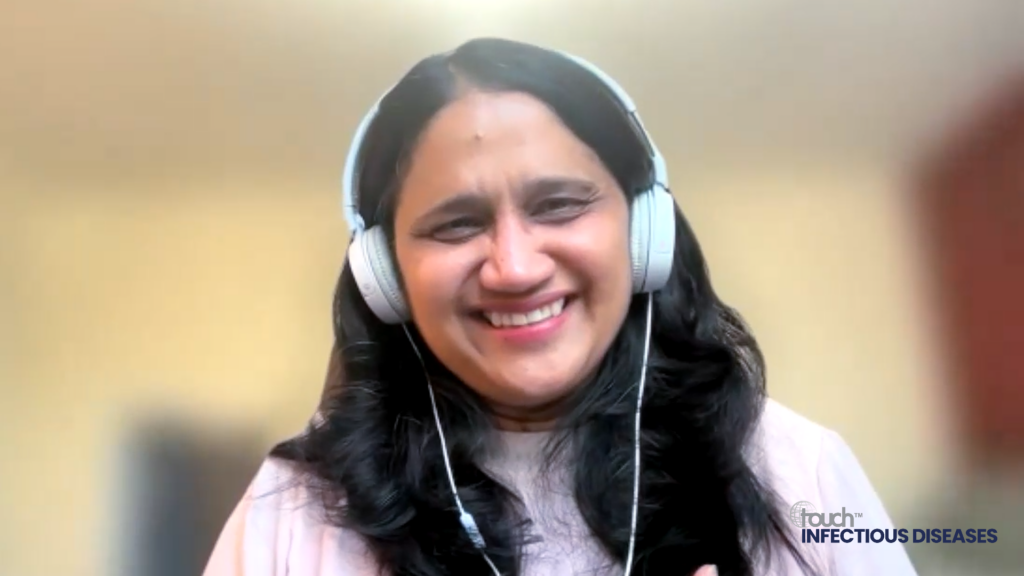touchINFECTIOUS DISEASES coverage of data presented at CROI 2024
HIV diagnostic technologies are evolving, with self-tests now widely accepted and multiplex tests offering accurate co-infection screenings. Dr Nitika Pai, Division of Clinical Epidemiology, Experimental Medicine, Infectious Disease, McGill University, Montreal, Canada, discusses the challenges that lie in deploying these advances strategically and utilizing machine learning to target high-endemic areas effectively.
Dr Pai highlights that despite the impressive sensitivity and specificity of molecular solutions, cost remains a significant barrier, particularly for Nucleic Acid Tests (NATs), limiting their accessibility. Omix-based and next-generation sequencing technologies are set to enhance diagnostic precision further, enabling personalized therapy and better management of drug resistance. CRISPR technology also emerges as a game-changer, potentially offering NAT-free testing at the point of care. Dr Pai has also worked in digital health for many years, and discussed how digital health has proven vital in improving care linkage, a success amplified by digital supports. Meanwhile, microfluidic wearables are on the horizon for rapid HIV detection, promising to integrate seamlessly into public health strategies.
Dr Pai also highlights the use of Machine learning, despite facing criticism for algorithmic bias, holds the potential to refine diagnostic decision-making. The evolution of HIV diagnostics has come a long way, aiming to serve not just the high-income populations but also the bottom billion, addressing the inequity at the core of pandemics. Beyond technology, addressing stigma and discrimination remains crucial for a holistic approach to ending HIV, underscoring the need for a humane strategy over mere technological advancement.
Disclosures: Nitika Pai has received grant/research Support from CIHR, FRSQ, and NIH.
This content has been developed independently by Touch Medical Media for touchINFECTIOUS DISEASES and is not affiliated with the Conference of Retroviruses and Opportunistic Infections (CROI). Unapproved products or unapproved uses of approved products may be discussed by the faculty; these situations may reflect the approval status in one or more jurisdictions. No endorsement of unapproved products or unapproved uses is either made or implied by mention of these products or uses by Touch Medical Media or any sponsor. Views expressed are the speaker’s own and do not necessarily reflect the views of Touch Medical Media.
Transcript:
Future directions of HIV diagnostic technologies
Self-tests have arrived; they’re done and dusted. There is a lot of evidence, and all we need to do is give more money to high-burden countries and procure more tests.
Multiplex tests
Multiplex tests are coming up with great data, and multiplex testing platforms have demonstrated high accuracy. Most high-risk individuals demand testing for co-infections. You cannot just do a carte blanche, carpet bombing approach, and screen everybody just because you have a hammer and everything looks like a nail. That’s not the philosophy. You need machine learning solutions to figure out which areas have the highest endoscopy of infection and which populations have the highest burden. Sometimes you don’t have data, so you can do some baseline surveys to get estimations of prevalence and incidence in subpopulations, and then use these technologies intelligently and target the right people for the right co-infection. So, co-infection screening has become very easy. Multiplex platforms, both molecular and antibody antigen-based platforms, are also high in accuracy. I’m talking about ninety-five percent sensitivity, which, in any other infectious diseases, would not be as celebrated as the high-quality products we have in HIV. For molecular solutions, we’re talking about a sensitivity of ninety-nine percent and specificity of ninety-nine percent.
Cost challenges
Obviously, they are very good. The challenge here is the cost, and so the cost of these cartridges, and the cost of these—I’m not a business person, so that has to be negotiated. So that more and more people can get access to them. But if you talk about NATs (Nucleic Acid Tests), I think NATs are not available everywhere. They are available in some parts of the world, but they’re only available in middle-income countries. Tertiary labs have access to them, secondary labs have access to them, but they are expensive. So you cannot use them for everybody. We need to make sure that there is some kind of pricing model that helps people who really want a NAT test, get that test. Because there’s no point in having these tests and making them available only to people from high-income settings.
Omix-based technologies
Then I see a lot of growth in omix-based technologies that’ll increase the precision in diagnostics. There’s genomics, metagenomics, there’s multiomics data. And that can be used in many different ways, they can be used as companion diagnostics while you are taking care of a patient—to figure out whether the patient is going to respond really well to therapy and whether there are certain aspects of metabolism that need to be investigated because not all patients are the same, and not everybody responds in the same way. There’s always a range of responses that you get. The other thing is these omix-based technologies are going to be very useful at the population level to really look at patterns in the data, at the population level.
Next-generation sequencing technologies
Then you have next-generation sequencing-based technologies. These next-generation sequencing-based technologies have changed the game and they are part of this whole omics revolution. And they are not separate unto themselves; they are all a combination of these sequencing platforms and have helped labs really get a handle because you can identify clusters of sequences, you can identify outbreaks really fast, you can look at low abundance drug resistance mutations, which you could never do before. Before, you would have to send the sample to the lab. So these options will become cheaper and more popular. And their interpretation has always been complex. It’s been harder to implement and to interpret their outputs. But now, because so many people are using them, I think it’ll become easier and easier to interpret the outputs. So you can look at drug resistance patterns with them, and that will help change the treatment game because you don’t then have to keep on going with the same regimens. You can switch. You can do a lot of personalized therapy.
CRISPR technologies
The other technology that I see has a lot of potential is CRISPR. I know there are a lot of people who have strong views about CRISPR, but I see that it’ll be one of the technologies that can offer NAT-free testing, which will be really good because CRISPR can be made portable, and there are some labs working in that space. And once this happens, you can detect point mutations at the point of care. You can test for genotypes at the point of care, and of course, we’re talking about drug resistance mutations. You can also perform this NAT-type testing, which is really expensive, and it can be made portable, convenient, just like self-tests. And you may probably have CRISPR-based self-tests. So I do foresee a lot of growth in that space, especially with,
Digital health in HIV
what’s to come. And then digital health—I mean, I’ve been doing digital health for a while and it accelerated during the COVID-19 pandemic. I feel that most of these support systems have shown that without digital supports, we could not get people linked to care. The linkage to care was 50-60 percent just with the provision of self-tests. But once you provide digital supports, it jumps up to 75-99 percent. In our studies, we found them to be 99 percent. But in different parts of the world that we’ve looked at the data, it varies from 75 to almost 99 percent, which I think is fantastic because we always worry that if it’s just enough to test people, it’s important to link them to care because testing and treatment go hand in hand. So linkage to care is going to improve at least with digital solutions.
Microfluidic-based wearables for rapid detection of HIV
Wearables are coming up now. Wearables are like these microfluidic-based wearables are coming up for rapid detection of HIV using recombinant polymerase amplification. I mean, that’s completely—it blows my mind that it is also going to happen. There are some cohort studies looking at sleep latency in HIV-positive individuals. So wearables are very popular in chronic disease management. Say, for example, diabetes, and other than the step count, but also for diabetes management has really changed because of wearables. There is so much overlap in infectious diseases and chronic diseases in all parts of the world and also in patient populations. They are going to help each other if we can figure out which metrics to use and what outcomes to look at. I think it is still in its infancy, but sleep latency is something that they have looked at in persons living with HIV. So I do see that wearable space with microfluidics can actually help if they can be more, you know, targeted about it. In terms of public health implementation, PEPFAR (U.S. President’s Emergency Plan for AIDS Relief) has used solutions and platforms to monitor sites, to improve communication, to make sure that people get linked to care, and to improve push notifications. Everything is going to become more efficient and easier, and it truly will become patient-centered care and not the other way around. This monitoring will improve errors, and you can look at different sites that are not performing really well for diagnostics. You can look at workflows. You can look at data transfers. You can always get all of that done in less amount of time with intelligent solutions, and these solutions improve efficiency.
Machine learning technologies
In machine learning, we have seen a lot of publications predicting the use of different kinds of models. The only downside with those models is that those scores that come out of them all depend on the dataset of where the scores come from. For example, you have to be very sensitive to that if you’re using a dataset that is from a Danish cohort study, please use it for the Danes and don’t try to use it for the Americans if you’re using a dataset with Americans. Make sure that you look at the proportional distributions of populations within that region. Ensure Hispanic Americans have been represented, and the African Americans have been represented, and use those variables because the variables that predict HIV are going to differ from the Caucasian Americans. That has been one of the biggest criticisms of machine learning-based models because there’s something called algorithmic bias. The bias really in the algorithms stems from the populations that are used to predict these algorithms.
But that being said, these different algorithms can also help you look at the precise combination of biomarkers that can be used. Without even using biomarkers, you can use algorithms to predict and to figure out which biomarker to use to test an individual patient. So those algorithms will be available at point of care, in handhelds and smartphones with apps, and also it’ll be very easy to figure out these diagnostic decision groups at the point of clinical care and support clinicians in their decision-making. We’ve looked at enhancing interpretation of rapid tests with image recognition, and we found a 5 percent jump in sensitivity.
With readers, we’ve also found that they increase the sensitivity and remove the ambiguity in notice and interpretation of tests and the clinical action plans that follow. They allow clinicians to make decisions based on the test result, and patients are also appreciative because they don’t have to come back for a second visit, ensuring everything gets done in one visit. Then, you have the labs (results) there in front of you. That can be a pain because people get impatient; they want the treatment action plans to begin ASAP.
But because you don’t waste time, and the beauty of rapid tests is rapid turnaround time and rapid linkage to care and reduction in losses to follow-up. And that metric really captures everything. You can reduce the losses to follow-up, like in the old and olden days at every step of the care continuum, and we used to lose 25 percent of patients every time, but now you can bring this number down.
You don’t necessarily need to lose patients because the positive patients have always wanted to be on treatment and they just want to be supported. So I feel that there is a lot to be learned with these new models and there’s going to be we’ve come a long way in HIV diagnostics.
We will continue to progress, and my only hope is that all of these technologies get used for the bottom billion because inequity is the heart of every pandemic. I think people who don’t have resources suffer – it’s been the story with COVID-19. It has always been the story in HIV, and I hope that we also deal with the other elephants in the room – technology and PrEP are not going to be enough. We have to talk about stigma, and make sure that discrimination ends for people that the diagnosis is not stigmatized, people are not made to feel embarrassed. This whole conversation is normalized, and people can lead a normal life. To me, a humane approach to ending HIV will be more important than just talking about tools and technologies because if you don’t think holistically, you cannot act holistically. And I think most big picture agencies are aligned on that count.
Interviewer/Editor: Katey Gabrysch









